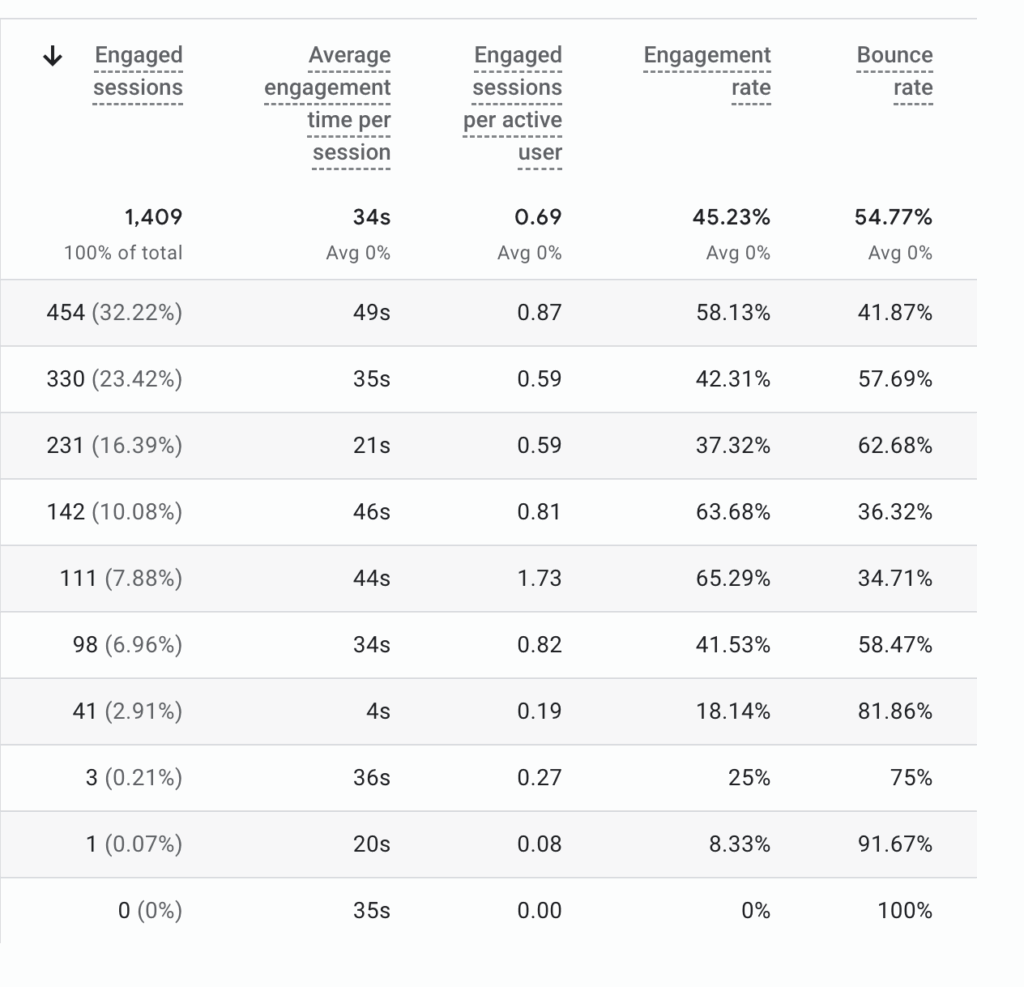How To Calculate Engagement Rate On Your Website
- SEO

If you read this title and thought this was going to be a blog about tracking engagements in your friend group, you might hit the back button once you realize it’s actually about website statistics—specifically, how to measure engagement rate on your website. Ironically, that quick exit perfectly illustrates the bounce rate concept we’re covering here!
But here’s the twist: in Google Analytics 4 (GA4), bounce rate isn’t the main focus anymore. GA4 puts the spotlight on a more meaningful metric.
While bounce rate measures who left quickly, engagement rate shows who stayed and interacted with your content. In this blog, we’ll break down how to calculate engagement rate, why it matters more than bounce rate in GA4, and what a good engagement rate website looks like.
What Is Bounce Rate?
Back in the old days (aka before GA4 was released in 2023), Universal Analytics used the bounce rate metric to measure user engagement. Bounce rate is the percentage of users on a site who only view one page before leaving.
However, it was very misleading.
Pages that were the most helpful for users (think: contact pages) had the highest bounce rates.
The reason? Users got the address, email, or phone number they were looking for and left (bounced) quickly.
Universal Analytics would say that’s not a success. But you and I know that helping the user contact a business is actually a huge success! The website did its job — and so did we for helping connect the business with a user who’s interested in buying.
And so, Google changed things (typical).
During the migration to GA4, the bounce rate fiasco was resolved with a new metric — engagement rate.
What Is Engagement Rate On Websites?
Engagement rate helps measure user engagement more in depth by tracking whether users took action through a key event, spent longer than 10 seconds on a page, or viewed more than two pages in a single session. Those who fall into any of those categories are considered an “engaged session.”
You can see this data reflected in the columns of your GA4 account, including:
- Engaged sessions
- Average engagement time per session
- Engaged sessions per active user
- Engagement rate
- Bounce rate

How To Calculate Engagement Rate
The engagement rate is the opposite of the bounce rate. So, if you have a 95% engagement rate, you’ll have a 5% bounce rate. If you have a 40% bounce rate, you have a 60% engagement rate, and so on.
GA4 calculates your engagement rate by taking the number of engaged sessions, dividing it by the total number of sessions, and multiplying by 100.

What Is A Good Engagement Rate On My Website?
If you’re wondering what a good engagement rate is vs an average engagement rate, it gets the classic SEO answer: it depends.
Why the mystery? Factors like channel, industry, and type of content all impact a page’s engagement rate. Let’s break these down:
How Channel Grouping Affects Engagement Rate
Let’s say you wrote a blog on new environmental legislation. You’ve shared the blog on social media, structured it well, built a link on an environmental nonprofit site, and created a great meta title and description for the page.
Most of your traffic to the page appears to be coming from social media, but you have a low engagement rate. What does this tell you?
It’s likely that those types of content don’t translate well for social media. Maybe your followers were hoping for different types of content, like an infographic rather than a lengthy article. Visuals are especially important on social media, as visual content is 40 times more likely to get shared than any other type of content.
This brings up an important point: always look at engagement rates from a holistic point of view.
Understanding where your traffic is coming from and what the audience is searching for is a direct correlation to user engagement.
If most of your traffic is being driven through organic search, consider what kind of content would work best. For example, are people searching for quick facts or more in-depth, research-driven pieces?
With the introduction of AI, users (and AI chatbots) are looking for reliable content that reflects expertise. Make sure you cover the topic thoroughly, have well-researched specialists writing your content, and keep your content direct yet accurate.
As with all SEO content, focus on user satisfaction, not the search engines’ satisfaction.
Need some help creating AI-friendly content?
How Industry Affects Engagement Rate
If you’re wondering what an average engagement rate is, you’re going to have to calculate it objectively by which industry your business is in. For example, a business in the consulting and professional services industry can get away with an average engagement rate of 52%. However, ecommerce businesses typically have an average engagement rate of almost 64%.
How Types Of Content Affect Engagement Rate
If the type of content in question is a blog, the engagement rate might be higher than other pages on your site for one simple reason: blogs are designed to answer questions the user might have, and they’ll stay on that page longer to read it all.
Other pages on your site, like an About Us page, might be helpful for credibility, but users might not take the time to read every detail. They might leave quicker, giving you a lower engagement rate.
Similarly, if your page contains many key event actions, there’s a greater chance the user will convert on that page rather than going to another page. That page might then have a higher engagement rate than a page without many opportunities for key events.
How Engagement Rate And Bounce Rate Affect Website SEO
While it’s a topic many SEOs have mixed opinions on, most agree that bounce rate and engagement rate have an indirect effect on a website’s SEO.
A high engagement rate can indicate the content is recent and relevant, and likely will be ranked higher. Similarly, one with a high bounce rate could indicate that the content is outdated or irrelevant, and will be ranked lower.
You may have heard of a related term, pogosticking, which, in terms of SEO, is when the user bounces back to the SERPs and chooses another result. This is a very strong signal to Google that the content they visited did not satisfy their needs. This type of interaction does influence rankings, as it subsequently affects user engagement.
In fact, even major sources like Semrush have published studies that confirm the ranking impact of bounce rates.
Follow the steps below to ensure your content attracts and holds the interest of your users.
Strategies To Increase Engagement Rates on Your Website
1. Include internal links to other pages of your site
Internal linking helps keep users on your site, showing Google that you are a relevant result to what they are searching for.
2. Avoid content that is hard to read
If your content is in a unique font or uses a color that is difficult to see, your users might leave. Avoid crazy colors and font types, and make sure the font is large enough to see easily, especially on mobile devices.
3. Increase page speed
If your site takes a while to load, users might get impatient and leave. Use the page speed insights test to make sure your site loads appropriately.
Add a lazy load to images, and ensure all images have alt text as a backup.
4. Add a table of contents
To help users easily scan your content, add a table of contents. That way, if they don’t scroll down far enough to find what they’re looking for right away, they can see it in the table of contents and click the link to jump to that section.
5. Make sure your page title matches (or is very similar to) your meta title
Keeping the page title the same as the meta title can prevent users from thinking they clicked on the wrong site. This can also decrease the chance that your meta title will be rewritten by Google.
6. Add call-to-actions
Call-to-actions (CTAs) can encourage users to complete key events, which increase your engagement rate.
7. Include images to increase scrolling
Adding images is a great way to encourage more scrolling and keep people reading. It also improves the look of your blog and captures attention. Visual content is proven to increase average engagement time and engaged sessions for blog content.
8. Include comprehensive content
Answer all of the users’ questions thoroughly so they don’t have to look for answers to their follow-up questions elsewhere. If they don’t find what they’re looking for on your site, they’ll bounce over to another site. Keep them engaged so you don’t lose them!
Need help understanding and calculating your engagement rate? Our GA4 specialists can dig into the data and find ways to maximize user engagement.
 By Lauren
By Lauren  Alex S
Alex S